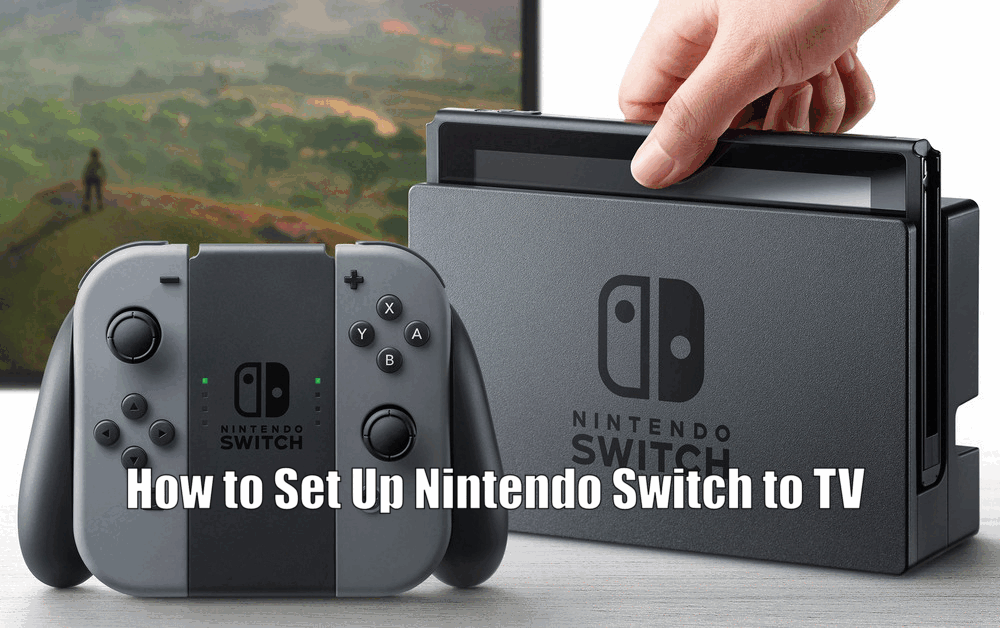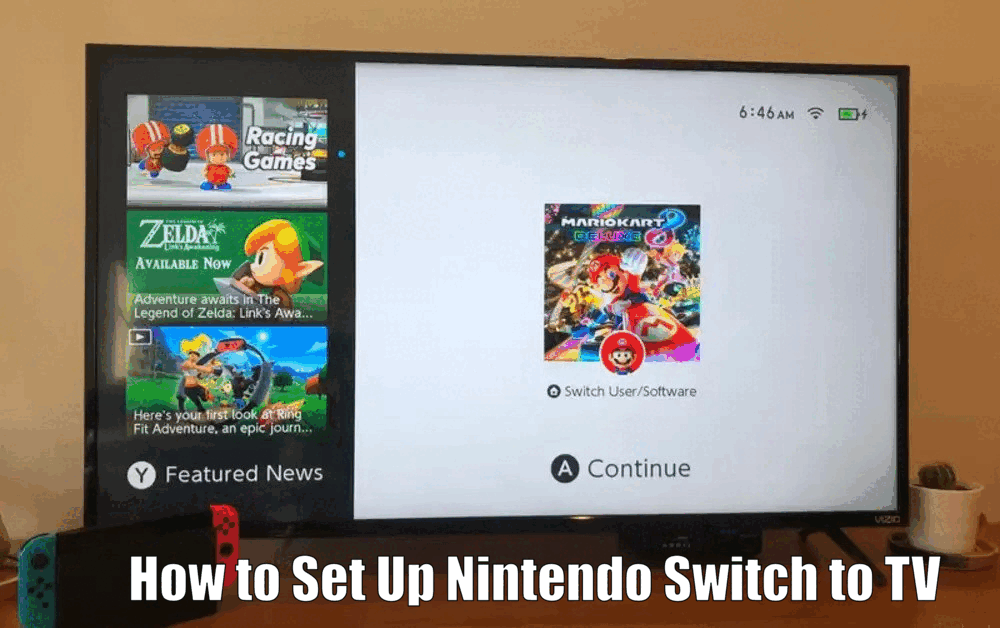Introduction
How to Set Up Nintendo Switch to TV: The Nintendo Switch console has revolutionized the gaming world with its unique hybrid design that allows for both handheld and home console gaming. As a compact, portable device, it offers the convenience of gaming on the go.
However, one of the most appealing features of the Nintendo Switch is its ability to easily connect to a TV, transforming the small-screen experience into an immersive, big-screen adventure.
Connecting your Nintendo Switch to a TV not only enhances your gaming experience by delivering better visuals and sound quality, but it also allows for multiplayer gaming on a larger scale.

Whether you’re racing in Mario Kart or battling it out in Super Smash Bros, the fun is significantly amplified when shared with friends and family on a big screen. Let’s explore how to set up your Nintendo Switch to your TV for an optimized gaming experience.
Gathering the Required Equipment
Before you begin setting up your Nintendo Switch, it’s essential to ensure that you have all the necessary equipment at hand. The primary component, of course, is the Nintendo Switch console itself, which includes the main unit and two Joy-Con controllers.
Next, you’ll need a TV that has an HDMI input as the Nintendo Switch console connects to the TV via an HDMI cable. It’s important to check if your TV has an available HDMI port to ensure compatibility. Additionally, make sure you have an HDMI cable that is long enough to connect the console to the TV comfortably.
In addition to the console and TV, you will also need a Nintendo Switch Dock. The Dock is an essential part of this setup as it allows the console to connect to the TV. An HDMI cable is used to connect the Dock to the TV, and an AC adapter powers the Dock.[How to Set Up Nintendo Switch to TV]
Finally, you will need the Joy-Con controllers, which provide the primary input for gameplay when the console is in TV mode.
Read Also how to hook up nintendo switch to tv Free Guide
Connecting the Nintendo Switch to the TV
The first step in connecting your Nintendo Switch to your TV involves positioning the TV and the Nintendo Switch Dock. Ideally, they should be in close proximity to each other to prevent any strain on the HDMI cable. Make sure to place the Dock near the TV, within reach of the HDMI cable.
Once the TV and Dock are positioned appropriately, you can begin the process of connecting the AC adapter to the Nintendo Switch Dock. Plug one end of the AC adapter into the Dock and the other end into a power outlet.
The next step is to connect the HDMI cable to the Nintendo Switch Dock and the TV. Ensure that one end of the HDMI cable is plugged into the HDMI OUT terminal on the Dock, and the other end is plugged into an HDMI IN terminal on the TV. It’s important to note the HDMI port number on the TV where you’ve connected the cable, as you will need to select the corresponding input source later.
After the physical connections have been established, you’ll need to adjust the TV’s input source to match the HDMI port you’ve used. Most TVs have a dedicated button on the remote control or the TV itself to cycle through different input sources. Keep pressing the button until you see the Nintendo Switch screen displayed on the TV.
Finally, power on your Nintendo Switch console by pressing the power button for at least three seconds. Once the console is powered on, you should see the Nintendo Switch menu on your TV screen, indicating a successful connection.[How to Set Up Nintendo Switch to TV]
Read Also How to Charge Nintendo Switch Controllers Without Dock

Configuring the Nintendo Switch Settings
After powering on your Nintendo Switch console, it’s time to configure the system settings. The first step involves choosing your preferred language and region. These settings will determine the language of the system’s interface and the availability of certain services and games. Select the appropriate language and region that best suits your preferences.
The next step is to configure internet connectivity by connecting your console to a Wi-Fi network. Navigate to the “Internet” section in the system settings menu and select “Internet Settings.” From there, choose your Wi-Fi network and enter the necessary credentials to establish a connection. Once connected, your Nintendo Switch will be able to access online features, multiplayer gaming, and the Nintendo eShop.
Once your console is connected to the internet, you’ll need to create or link a Nintendo Account. This account gives you access to the Nintendo eShop and allows you to purchase and download games. Follow the on-screen prompts to either create a new Nintendo Account or link an existing one to your console.
The final step in configuring your Nintendo Switch settings is setting up user profiles. Each user profile stores save data separately, so multiple people can have their own save files on the same console. Navigate to the “Users” section in the system settings menu and select “Add User.” Follow the prompts to create a new user profile, including selecting an icon and entering a nickname.[How to Set Up Nintendo Switch to TV]
Calibrating the Joy-Con Controllers
With your Nintendo Switch connected to the TV and your system settings configured, it’s time to calibrate your Joy-Con controllers. Start by detaching the Joy-Con controllers from the Nintendo Switch console. Hold the Joy-Con controllers in the desired grip, either in each hand or attached to the Joy-Con grip.
Once you’re holding the controllers, use the console’s touchscreen to navigate to the “Controllers and Sensors” section of the system settings. From there, select “Calibrate Control Sticks” and follow the prompts to calibrate your Joy-Con controllers. This calibration process ensures that the controllers respond accurately to your movements, providing a seamless gaming experience.

Exploring TV Modes and Display Options
One of the unique features of the Nintendo Switch is its versatility. In handheld mode, you can enjoy gaming on the go, while TV mode provides a more immersive experience. Adjusting the display settings for optimal picture quality is an essential step for getting the best out of your TV mode experience.
To access the display settings, navigate to the “TV Output” section in the system settings menu. From there, you can adjust the screen size, resolution, and more to suit your preferences and the capabilities of your TV. Experiment with different settings to find the optimal balance between visuals and performance.
Additionally, the Nintendo Switch offers various sound options that can be enabled or disabled based on your preferences. In the “TV Output” section of the system settings menu, you can adjust the audio settings, such as volume, surround sound, and audio output mode. Take the time to explore these options and customize the audio experience to your liking.[How to Set Up Nintendo Switch to TV]
Troubleshooting Tips
Even with the most careful setup, you may encounter some issues while connecting your Nintendo Switch to your TV. Some common issues include the console not displaying on the TV, no sound, or the Joy-Con controllers not responding. Most of these issues can be resolved by checking your connections, resetting your console, or recalibrating your controllers.
If you’re experiencing any issues, start by ensuring that all the cables are securely connected and that the HDMI cable is plugged into the correct ports on the Dock and TV. If the console is not displaying on the TV, try cycling through the input sources again or try a different HDMI port on the TV.
If you’re still having trouble, you can try resetting your console by holding down the power button for at least 15 seconds until the screen goes black. Then, power on the console again and see if the issue persists.
In the case of unresponsive Joy-Con controllers, try detaching and reattaching them to the console or recalibrating them as mentioned earlier. If none of these troubleshooting steps work, don’t hesitate to contact Nintendo Support for further assistance. They have a team of experts ready to help you resolve any issues you may be experiencing.
Conclusion – How to Set Up Nintendo Switch to TV
Setting up your Nintendo Switch to your TV may seem like a daunting task at first, but by following these steps, you’ll be up and running in no time. From gathering the necessary equipment to configuring your settings, each step plays a crucial role in ensuring an enhanced gaming experience.
Remember, the goal is not just to set up your console, but to optimize your setup for the best possible gaming experience. Whether you’re a solo player or love playing with friends and family, a properly set-up Nintendo Switch console can provide countless hours of fun and enjoyment.[How to Set Up Nintendo Switch to TV]
So, grab your Joy-Con controllers, connect your Nintendo Switch to the TV, and get ready to embark on exciting gaming adventures on the big screen.
How to Set Up Nintendo Switch to TV – FAQs
Q1: What are the key features of the Nintendo Switch?
A1: The key features of the Nintendo Switch include portability, multiplayer capability, and versatile Joy-Con controllers.
Q2: What equipment do I need to connect my Nintendo Switch to my TV?
A2: You will need the Nintendo Switch console, docking station, HDMI cable, Joy-Con controllers, AC adapter, and a TV with an available HDMI port.
Q3: How do I connect my Nintendo Switch to my TV?
A3: Connect the docking station to your TV using the HDMI cable, place the Nintendo Switch console into the docking station, and power on your TV. Select the appropriate HDMI input source to see the Nintendo Switch interface on your TV screen.
Q4: How can I optimize my TV settings for the Nintendo Switch?
A4: Adjust your TV’s display settings to the appropriate resolution, adjust audio settings for the best sound experience, and enable game mode if available to reduce input lag.
4 thoughts on “How to Set Up Nintendo Switch to TV Beginner’s Guide”